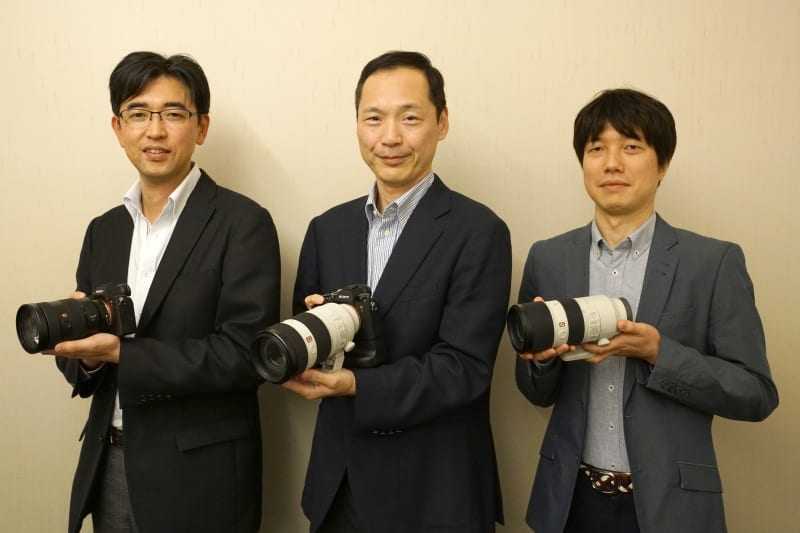Οι κύριοι Sony a Series είναι αυτοί. Σε μια πολύ ενδιαφέρουσα συνέντευξη, στην έδρα της Sony, στο Imaging Products & Solutions Corporation Digital Imaging Headquarters. οι κύριοι Mr. Masanori Kishi, manager of second business unit (Lens & Peripheral), Yasuyuki Nagata of senior general manager of second business unit (Lens & Peripheral), Masanori Kanai, director of optical designing of optical design department, core technology division 1 μίλησαν για όλα και έδωσαν απίστευτα ενδιαφέροντα πράγματα για το πως σχεδιάζονται φακοί, σώματα και όλα τα καλά!
Στα βασικά όπως τα μεταφέρει το sonyaddict.com τα παρακάτω:
- Customers the shoot portraits often assign Eye AF to the focus hold button on the lens
- G Master lenses are tuned for photography and videography
- Photography and videography AF are very different algorithms
- They suppress changes in angle of view on G Master lenses because they appear unnatural in video
- Many use manual focus for movie production in addition to photography
- Sony doesn’t design G Master lenses with size/weight restrictions in mind beyond them being reasonable. Optical performance comes first.
- Originally they tried to stay below 77mm, but they ended up going up to 82mm so they wouldn’t have to bend the light in ways that would affect optical quality.
- Would only increase the size of the lens to increase resolving power.
- Resolution and blur tend to not be compatible and the more resolution you add the harder the blur becomes.
- The ideal point where resolution and blur quality meet is hard to hit and that’s why there has to be very tight manufacturing standards.
- Sony thinks they can hit 50 lines per mm when most only hit 30 lines per mm.
- Sony tries to raise high-frequency and low-frequency MTF, but it can affect sharpness or blur.
- You can’t compare the quality of film lenses and digital lenses.
- 100mm and 85mm lenses are designed to have optimal blur at portrait focal lengths.
- It is now possible to simulate the designs to achieve the best balance.
- Blur simulation lets the camera side characteristics be examined instead of a point like on a spot diagram.
- The Right side is an example of what G Master lenses aim for.
Περισσότερα εδώ.
- It’s only an example but “the shape of blur changes according to the distance to the subject and the positional relationship with the background, we will make delicate balancing so that the blurred image becomes close to the ideal at any distance”
- There is an emphasis on getting blur right at closer distances than infinity.
- Sony accuracy of curved surface and surface roughness are “orders of magnitude higher than conventional aspheric lenses with high precision.”
- These are being produced at Sony Global Manufacturing & Operations Co., Ltd., Kota site and use proprietary methods.
- More diaphragm blades aren’t the answer for better bokeh and can cause resistance.
- Sony uses linear motors and magnets in there AF system that are optimized for the specific G Master lens.
- “Currently adopted methods of actuators are the ring drive SSM, and the linear motor we introduced, and the direct drive SSM (DDSSM). DDSSM is a driving method based on ultrasonic vibration, but it is a motor that generates driving force directly in the straight direction rather than generating driving force in the direction of rotation like the ring drive SSM. Since it is unnecessary to convert rotational motion into linear motion, unnecessary load of the driving member can be minimized, and a focus driving structure with high speed and very responsiveness can be realized.”
- DDSSM is driven by ultrasonic vibration, while the linear motor is driven by electromagnetic force, but both are considered linear motors.
- “The optical merit of floating focus is that you can achieve a high level of image quality from infinity to close up.”
- “By moving two focusing units independently, you can shorten the shortest shooting distance and further improve the image quality in the immediate vicinity.”
- “100-400 mm has two systems in front and behind, but they are driven using completely independent actuators, respectively.”
- The 100-400mm has DDSSM on the front side and double linear motor on the back side.
- “moving multiple lightweight focus groups is more advantageous in terms of responsiveness than moving one heavy focus group”
- “control of two focus units must be perfectly synchronized and controlled, just because one focus unit is misaligned will make it impossible to focus”
- “In telephoto lenses, the correction amount of camera shake increases, so it is often advantageous to incorporate a camera shake correction mechanism on the lens side.”
- “When there is a camera shake correction mechanism on the lens side, basically rolling (direction of rotation) and shift shake are compensated to some extent, such as correction on the body side.”
- Magnesium alloy was used inside the 100-400mm to keep weight down and is an example of how G Master lenses don’t compromise.
- The anti vibration unit from the 100 mm STF was used in the 100-400mm.

